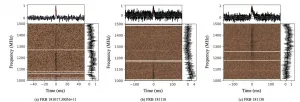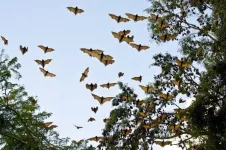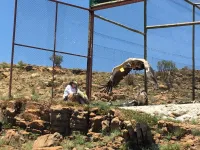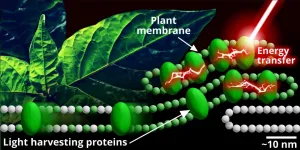(Press-News.org) Scientists using NASA's Hubble Space Telescope have found evidence that a planet orbiting a distant star may have lost its atmosphere but gained a second one through volcanic activity.
The planet, GJ 1132 b, is hypothesized to have begun as a gaseous world with a thick hydrogen blanket of atmosphere. Starting out at several times the diameter of Earth, this so-called "sub-Neptune" is believed to have quickly lost its primordial hydrogen and helium atmosphere due to the intense radiation of the hot, young star it orbits. In a short period of time, such a planet would be stripped down to a bare core about the size of Earth. That's when things got interesting.
To the surprise of astronomers, Hubble observed an atmosphere which, according to their theory, is a "secondary atmosphere" that is present now. Based on a combination of direct observational evidence and inference through computer modeling, the team reports that the atmosphere consists of molecular hydrogen, hydrogen cyanide, methane and also contains an aerosol haze. Modeling suggests the aerosol haze is based on photochemically produced hydrocarbons, similar to smog on Earth.
Scientists interpret the current atmospheric hydrogen in GJ 1132 b as hydrogen from the original atmosphere which was absorbed into the planet's molten magma mantle and is now being slowly released through volcanic processes to form a new atmosphere. The atmosphere we see today is believed to be continually replenished to balance the hydrogen escaping into space.
"It's super exciting because we believe the atmosphere that we see now was regenerated, so it could be a secondary atmosphere," said study co-author Raissa Estrela of NASA's Jet Propulsion Laboratory (JPL) in Pasadena, California. "We first thought that these highly irradiated planets could be pretty boring because we believed that they lost their atmospheres. But we looked at existing observations of this planet with Hubble and said, 'Oh no, there is an atmosphere there.'"
The findings could have implications for other exoplanets, planets beyond our solar system.
"How many terrestrial planets don't begin as terrestrials? Some may start as sub-Neptunes, and they become terrestrials through a mechanism that photo-evaporates the primordial atmosphere. This process works early in a planet's life, when the star is hotter," said lead author Mark Swain of JPL. "Then the star cools down and the planet's just sitting there. So you've got this mechanism where you can cook off the atmosphere in the first 100 million years, and then things settle down. And if you can regenerate the atmosphere, maybe you can keep it."
In some ways GJ 1132 b, located about 41 light-years from Earth, has tantalizing parallels to Earth, but in some ways it is very different. Both have similar densities, similar sizes, and similar ages, being about 4.5 billion years old. Both started with a hydrogen-dominated atmosphere, and both were hot before they cooled down. The team's work even suggests that GJ 1132 b and Earth have similar atmospheric pressure at the surface.
But the planets have profoundly different formation histories. Earth is not believed to be the surviving core of a sub-Neptune. And Earth orbits at a comfortable distance from our Sun. GJ 1132 b is so close to its red dwarf star that it completes an orbit around its host star once every day and a half. This extremely close proximity keeps GJ 1132 b tidally locked, showing the same face to its star at all times--just as our Moon keeps one hemisphere permanently facing Earth.
"The question is, what is keeping the mantle hot enough to remain liquid and power volcanism?" asked Swain. "This system is special because it has the opportunity for quite a lot of tidal heating."
Tidal heating is a phenomenon that occurs through friction, when energy from a planet's orbit and rotation is dispersed as heat inside the planet. GJ 1132 b is in an elliptical orbit, and the tidal forces acting on it are strongest when it is closest to or farthest from its host star. At least one other planet in the host star's system also gravitationally pulls on the planet.
The consequences are that the planet is squeezed or stretched through this gravitational "pumping." That tidal heating keeps the mantle liquid for a long time. A nearby example in our own solar system is Jupiter's moon Io, which has continuous volcanic activity due to a tidal tug-of-war from Jupiter and the neighboring Jovian moons.
Given GJ 1132 b's hot interior, the team believes the planet's cooler, overlying crust is extremely thin, perhaps only hundreds of feet thick. That's much too feeble to support anything resembling volcanic mountains. Its flat terrain may also be cracked like an eggshell due to tidal flexing. Hydrogen and other gases could be released through such cracks.
NASA's upcoming James Webb Space Telescope has the ability to observe this exoplanet. Webb's infrared vision may allow scientists to see down to the planet's surface. "If there are magma pools or volcanism going on, those areas will be hotter," explained Swain. "That will generate more emission, and so they'll be looking potentially at the actual geologic activity--which is exciting!"
INFORMATION:
The team's findings will be published an upcoming issue of The Astronomical Journal.
Artwork:
NASA, ESA, and R. Hurt (IPAC/Caltech)
Science: NASA, ESA, and M. Swain (Jet Propulsion Laboratory)
Media Contacts:
Claire Andreoli
NASA's Goddard Space Flight Center, Greenbelt, Md.
301-286-1940
claire.andreoli@nasa.gov
Ann Jenkins / Ray Villard
Space Telescope Science Institute, Baltimore, Maryland
410-338-4488 / 410-338-4514
jenkins@stsci/edu / villard@stsci.edu
Science Contacts:
Mark Swain / Raissa Estrela
Jet Propulsion Laboratory, Pasadena, California
mark.r.swain@jpl.nasa.gov / restrela@jpl.nasa.gov
ROCHESTER, Minn. -- Ten days after receiving a second dose of a messenger RNA, or mRNA, vaccine for COVID-19, patients without COVID-19 symptoms are far less likely to test positive and unknowingly spread COVID-19, compared to patients who have not been vaccinated for COVID-19. The Pfizer-BioNTech and Moderna messenger RNA vaccines for COVID-19 are authorized for emergency use in the U.S.
With two doses of a messenger RNA COVID-19 vaccine, people with no symptoms showed an 80% lower adjusted risk of testing positive for COVID-19 after their last dose. Those are the findings of a Mayo Clinic study of vaccinated patients. These finding appear in the journal Clinical Infectious Diseases.
The authors say these findings underscore ...
A study conducted by researchers at the University of Rochester Medical Center (URMC) - in collaboration with several other universities - indicates that breastfeeding women with COVID-19 do not transmit the SARS-CoV-2 virus through their milk, but do confer milk-borne antibodies that are able to neutralize the virus.
The study, "Characterization of SARS-CoV-2 RNA, antibodies, and neutralizing capacity in milk produced by women with COVID-19," published on February 9 in the journal mBio - analyzed 37 milk samples submitted by 18 women diagnosed with COVID-19. None of the milk samples were found to contain ...
Fast radio burst (FRB) is a kind of mysterious radio flashes lasting only a few thousandths of a second. Confirmed to be the cosmological origin in 2016, FRB has the potential to provide insights into a wide range of astrophysical problems.
Dr. NIU Chenhui from the team led by Dr. LI Di and Dr. ZHU Weiwei from National Astronomical Observatories of Chinese Academy of Sciences discovered three new FRBs with high dispersion measure from the massive data of the Five-hundred-meter Aperture Spherical radio Telescope (FAST).
Their findings were published in The Astrophysical Journal Letters on March 3.
The discovery indicated that these three FRBs happened billions of years ago when the ...
Intrauterine growth restriction (IUGR) is common and concerning, but few therapeutic options exist for pregnant mothers who receive this diagnosis. IUGR is a condition in which a baby in the womb is measuring small for its gestational age, often because of issues with the placenta, resulting in compromised or insufficient transfer of oxygen and nutrients to the growing fetus. The developing fetal brain is particularly vulnerable to these effects. One out of every 10 babies is diagnosed with IUGR, and infants with IUGR are at increased risk of death and neurodevelopmental impairment. ...
Biologists from RUDN University suggested adding a marjoram-based supplement to the diet of common carp to support the growth of the fish and improve their resistance to bacterial infections. The results of the study were published in the Fish & Shellfish Immunology journal.
Cyprinus carpio is a type of large omnivore fish that grows 35-40 cm long in three to five years. 4 mln tons of carps were bred in aquacultural farms in 2010. Such farms protect natural populations of Cyprinus carpio while at the same time satisfying the market demand. However, as farmers strive for higher productivity, aquacultural farms become more and more crowded which leads to the lack of nutrients and harms the health of the fish. A team of veterinarians ...
CABI scientist Dr Arne Witt has shared his expertise on invasive alien plant species as part of a new paper which argues that healthy ecosystems are vital in reducing the risk of future pandemics - such as coronaviruses (including COVID-19) - that threaten human health.
The paper - 'Land use-induced spillover: priority actions for protected and conserved area managers' - is published as part of a special issue by the journal PARKS entitled 'COVID-19 and Protected Areas: Essential Reading for a World Haunted by a Pandemic.'
Lead author Dr Jamie K. Reaser - along with a team of researchers from institutions including the African Wildlife Foundation, the University ...
Exposure to SARS-Co-V2, the virus that causes COVID-19, can put otherwise healthy children and adolescents at risk for Multisystem Inflammatory Syndrome in Children (MIS-C), a rare but possibly life-threatening pediatric condition that can cause severe inflammation in organs like the heart, brain, lungs, kidneys and gastrointestinal system.
Diagnosing and treating MIS-C -- which has affected 2,600 children since May 2020 and is known to occur in children who have tested positive for SARS-Co-V2 or been exposed to someone with COVID-19 -- is difficult because respiratory and gastrointestinal symptoms can be similar to severe COVID-19. Other features of MIS-C are very similar to Kawasaki disease, which causes inflammation ...
Rare earth elements are the gold of the 21st century: rare and highly prized all over the world. Most known and economically viable sources of rare earths are located in China, where more than 80 percent of them are refined. This has resulted in a near monopoly situation, with China dominating international trade, particularly in heavy rare earths. Geologists and materials scientists at FAU have now discovered a new way of finding new and previously unknown deposits of rare earths, or rare earth metals, worldwide. They have published the findings of their study in the journal Geology.
Rare earth metals are irreplaceable for manufacturing advanced high-tech industrial products due to their luminescent and ...
Conservationists who apply wing tags for identifying Cape Vultures--a species of African vulture that is vulnerable to extinction--are putting the birds' lives further at risk, a new movement ecology study has shown. Researchers from the Max Planck Institute of Animal Behavior in Germany and VulPro NPC in South Africa have demonstrated that Cape Vultures fitted with tags on their wings travelled shorter distances and flew slower than those fitted with bands around their legs. The research emphasises the importance of investigating the effects that tagging methods can have on the behaviour and conservation of species, prompting a shift towards the ...
New scientific techniques are revealing the intricate role that proteins play in photosynthesis.
Despite being discovered almost 300 years ago, photosynthesis still holds many unanswered questions for science, particularly the way that proteins organise themselves to convert sunlight into chemical energy and at the same time, protect plants from too much sunlight.
Now a collaboration between researchers at the University of Leeds and Kobe University in Japan is developing a novel approach to the investigation of photosynthesis.
Using hybrid membranes that mimic natural plant membranes and advanced microscopes, they are opening photosynthesis to nanoscale investigation - the study of life at less than one billionth ...





